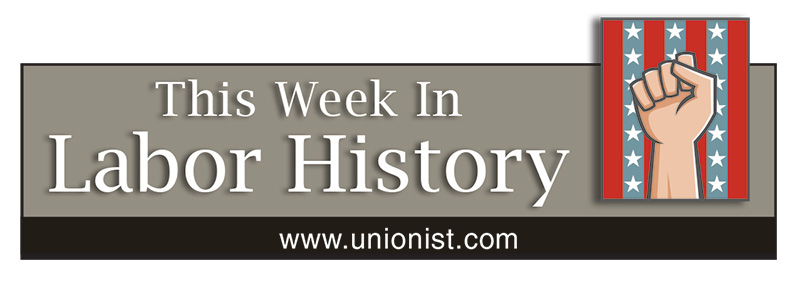This week in labor history: June 22-28

JUNE 22
1918 – A total of 86 passengers on a train carrying members of the Hagenbeck-Wallace Circus are killed, another 127 injured in a wreck near Hammond, Ind. Five days later the dead are buried in Woodlawn Cemetery in Forest Park, Ill., in an area set aside as Showmen’s Rest, purchased only a few months earlier by the Showmen’s League of America.
1922 – Violence erupts during a coal mine strike at Herrin, Ill. A total of 36 were killed, 21 of them non-union miners.
JUNE 23
1914 – Charles Moyer, president of the Western Federation of Miners, goes to Butte, Mont., in an attempt to mediate a conflict between factions of the miners’ local there. It didn’t go well; a gunfight in the union hall killed one man. Moyer and other union officers left the building, which was then leveled in a dynamite blast.
1947 – Congress overrides President Harry Truman’s veto of the anti-worker Taft-Hartley Act. The law weakened unions and let states exempt themselves from union requirements. Twenty states immediately enacted open shop “right-to-work” laws and more followed.
1978 – OSHA issues standard on cotton dust to protect 600,000 workers from byssinosis, also known as “brown lung.”
1999 – A majority of the 5,000 textile workers at six Fieldcrest Cannon textile plants in Kannapolis, N.C., vote for union representation after an historic 25-year fight.
JUNE 24
1880 – Birth of Agnes Nestor, president of the Int’l Glove Workers Union and longtime leader of the Chicago Women’s Trade Union League. She began work in a glove factory at age 14.
1971 – Seventeen workers are killed as methane explodes in a water tunnel under construction in Sylmar, Calif.
JUNE 25
1893 – More than 8,000 people attend the dedication ceremony for The Haymarket Martyrs Monument in Chicago, honoring those framed and executed for the bombing at Haymarket Square on May 4, 1886.
1938 – Fair Labor Standards Act passes Congress, banning child labor and setting the 40-hour work week.
1941 – At the urging of Black Labor and civil rights leader A. Philip Randolph, Franklin Roosevelt issues an executive order barring discrimination in defense industries.
1943 – Congress passes the Smith-Connally War Labor Disputes Act over President Franklin Roosevelt’s veto. It allows the federal government to seize and operate industries threatened by strikes that would interfere with war production. It was hurriedly created after the third coal strike in seven weeks.
1985 – A total of 21 workers are killed when a fireworks factory near Hallett, Okla., explodes.
1994 – Decatur, Ill., police pepper-spray workers at A.E. Staley plant gate one year into the company’s two-and-a-half-year lockout of Paperworkers Local 7837.
JUNE 26
1894 – Members of the American Railway Union, led by Eugene V. Debs, refuse to handle Pullman cars, in solidarity with Pullman strikers. Two dozen strikers were killed over the course of the strike.
1959 – The 189-mile-long St. Lawrence Seaway opens, making the Great Lakes accessible to Atlantic shipping. Thousands of laborers toiled for decades to make it happen; indirectly and directly, the Seaway today supports 75,000 jobs in Canada and 150,000 in the U.S.
JUNE 27
1869 – Emma Goldman, women’s rights activist and radical, born in Lithuania. She came to the U.S. at age 17.
1905 – The Industrial Workers of the World, also known as the “Wobblies,” is founded at a 12-day-long convention in Chicago. The Wobbly motto: “An injury to one is an injury to all.”
1935 – Congress passes the National Labor Relations Act, creating the structure for collective bargaining in the United States.
1985 – A 26-day strike of New York City hotels by 26,000 workers—the first such walkout in 50 years—ends with a five-year contract calling for big wage and benefit gains.
1993 – A.E. Staley locks out 763 workers in Decatur, Ill. The lockout was to last two and one-half years.
2018 – The U.S. Supreme Court rules that state and local public-sector unions cannot require nonunion members to pay anything to support the collective bargaining, grievance-handling and other costs of union work on their behalf. Voting with the 5-4 majority was Neil Gorsuch, who had just been named to the court by President Donald Trump.
JUNE 28
1850 – Birthday of machinist Matthew Maguire, who many believe first suggested Labor Day. Others believe it was Peter McGuire, a carpenter.
1894 – President Grover Cleveland signs legislation declaring Labor Day an official U.S. holiday.
1944 – A Liberty Ship named after the founding president of the American Federation of Labor, Samuel Gompers, is launched in Sausalito, Calif. She replaced a cargo steamship bearing Gompers’ name which had been torpedoed and sunk by a Japanese sub in the South Pacific the previous year.
1988 – The federal government sues the Teamsters to force reforms on the union, the nation’s largest. The following March, the government and the union sign a consent decree requiring direct election of the union’s president and creation of an Independent Review Board.
(Compiled by David Prosten, founder Union Communication Services)


Leave a Reply